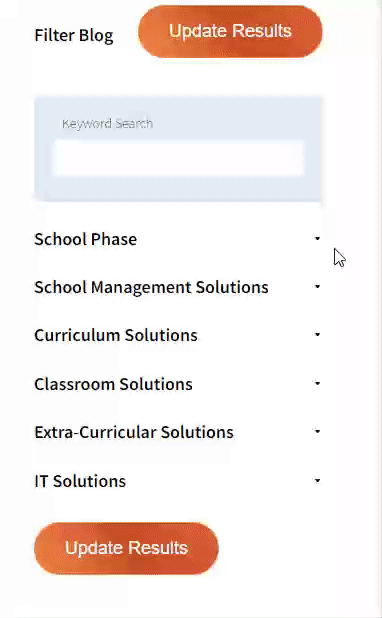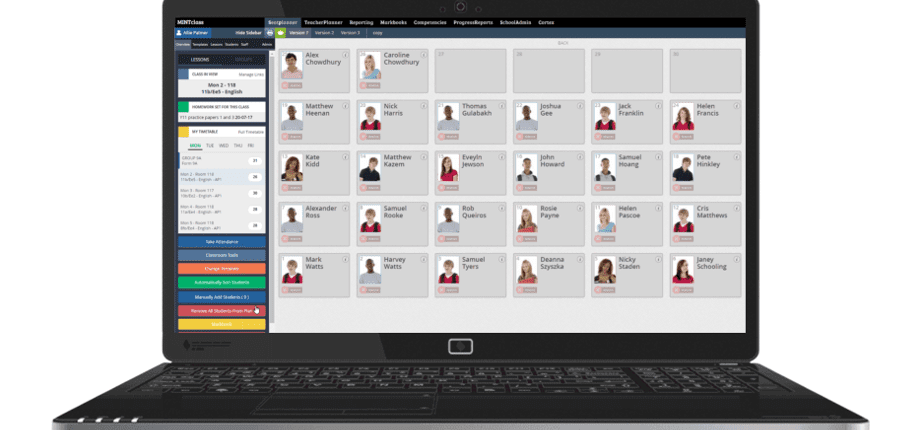


Our team sorts through all blog submissions to place them in the categories they fit the most - meaning it's never been simpler to gain advice and new knowledge for topics most important for you. This is why we have created this straight-forward guide to help you navigate our system.


And there you have it! Now your collection of blogs are catered to your chosen topics and are ready for you to explore. Plus, if you frequently return to the same categories you can bookmark your current URL and we will save your choices on return. Happy Reading!
There’s no magic bullet in a seating plan and no such thing as a perfect arrangement – but it is all too easy to get it wrong. Clinical psychologist Dr Asha Patel, CEO of Innovating Minds, offers some advice to schools.

Seating plans for a classroom are even more complicated than organizing who sits where at a wedding reception. Like so much else in education you need to define your objectives. It is not just about making sure sworn enemies are not seated side by side. Instead, you must think about the individual needs – is the child with ADHD better sitting right in front of you where you can keep an eye on them, or by a wall where they only have a child on one side of them?
Is it best to have a child who experiences sensory overload in a quiet area on a separate single table or put them with a small sympathetic group who may be able to provide support? Seating plans should not just be about dealing with incipient discipline problems but about making sure every pupil is going to get the best out of the lesson.
If students can choose their own seats you will find that after one or two lessons the seating plan is fixed. It also gives you an insight into many aspects of pupils’ relationships. Who sits at the back all the time? Are they doing this to because that is where the most popular children sit or because they want to hide and think that if they sit far back, they will not be subject to the same scrutiny?
We all like to think that we have mastered classroom management but in fact recent work by a commercial company that puts cameras in classrooms tracked teachers’ eye gaze and revealed that some children literally never get a look in. It is easy to see how this happens. There are some children with autism or ADHD who need to be checked regularly to make sure they understand, are on task, calm and not about to go off track. There are the dominant personalities who attract attention, probably because they are vocal and keen to answer questions. But it is your job as a teacher to make sure everyone is included.
Here Are Some Key Considerations
Flexibility is the key to successful seating plans. Many teachers will be constrained by the physical position of the furniture in a classroom but see if you can accommodate quiet purposeful individual work and easily move students around for small group exercises. Is everything geared to a front of the classroom approach, or is there a clear corner which can be used for role play or for a child who needs a time-out in a small space?
There is no single recipe for success and many a teacher has had to change their seating plan during the year. This is where technology comes to the rescue. Once, teachers spent hours laboriously moving bits of paper round a grid, but as well as being time-consuming it was not possible to share the information with a wider group, so the effort and results often went unrecognized.
Now we are beginning to realize the complexities of human relationships in the classroom, and like planning the seating for a wedding reception, who sits where is far too important to be left to chance.
Want to learn how to harness psychology to better organize and manage your classroom?
Click HERE to download our free blueprint for more effective classroom management!


The author

Read more

Read more

Read more

Read more

Read more

Read more

Read more

Read more


Are you looking for solutions? Let us help fund them! Nexus Education is a community of over 11,000 schools that come together to share best practise, ideas and CPD via online channels and free to attend events. Nexus also offers funding to all school groups in the UK via nexus-education.com


Established in 2011, One Education is a company at the heart of the education world, supporting over 600 schools and academies. Our unique appeal as a provider is in the breadth and synergy of the services we offer, supporting school leaders, teachers and support staff to achieve the best possible outcomes for their pupils and staff.

School Space is a social enterprise that has empowered schools for over 12 years through their profitable and hassle-free lettings services. So far, they’ve generated over £5 million in revenue for education, helping to connect over 200 schools with their local communities.


Operoo is a school operations and productivity platform. We help thousands of schools and trusts to eliminate slow, expensive and repetitive tasks. Operoo helps schools streamline and digitise processes, drastically reducing the associated costs: From student pre-admissions, permission forms, payments, and school trips; to medical information and emergency contacts, incident reporting, staff agreements, and more in over 100 languages.


Unify is an online sales and marketing tool that allows users to create tailored personalised documents in moments.


There’s nothing special about the energy we sell. In fact, it’s exactly the same energy as all our competitors provide. But there is something special about the way we do it. Where others complicate the process, we simplify it. Where others confuse customers with hidden terms, we’re an open book. And where others do all they can to make as much money from their customers as possible, we do all we can to make as little. Everything we do, we do it differently. Our customers are a privilege. One we’ll never take advantage of.


Securus provide market-leading monitoring solutions to safeguard students on ALL devices both online and offline. We also offer a full monitoring service, where we carry out the monitoring on behalf of the school, freeing up valuable staff resources. From the smallest school to large MAT groups, Securus offers safeguarding protection for all!


As European leaders of Time Management Solutions, Bodet offer Lockdown, Clock, Bell & PA Systems. Harmonys, our five-in-one IP/PoE Bell System, provides a unique customisable lockdown or panic alarm alert. Melodys, a Wireless Bell System, is useful where wiring can be difficult.